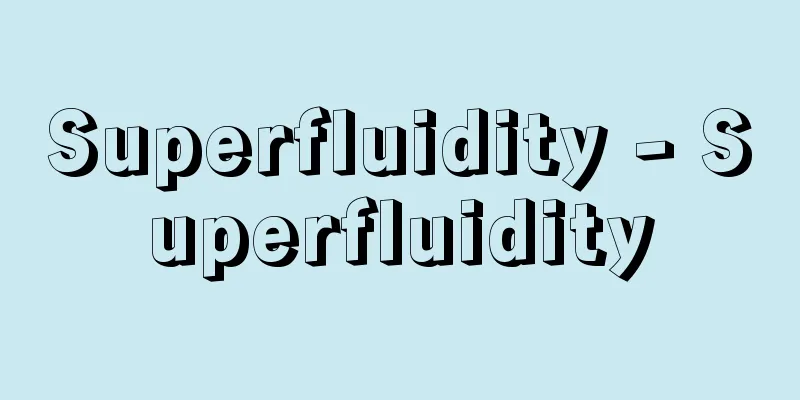Superfluidity - Superfluidity

|
A liquid state in which there is no viscosity whatsoever and no vortexes when it flows. This phenomenon has only been found in liquid helium at low temperatures below 2.17 K (absolute temperature), and has not been observed in other liquids. A liquid that exhibits superfluidity is called a superfluid. Among liquid helium, the only one that exhibits superfluidity below 2.17 K is the naturally occurring 4He with mass number 4. Its isotope, 3He with mass number 3, does not exhibit superfluidity at this temperature. In 1972, it was discovered that 3He exhibits superfluidity below 2.7 milliK (1 milliK is 1/1000 of K). A strange phenomenon can be observed in superfluid helium. As shown in , when a bucket is placed in liquid helium below 2.17 K, the liquid helium forms a thin film and rises along the walls of the bucket, entering the bucket. When the bucket is lifted above the liquid level, the liquid flows back along the walls and out of the bucket. This phenomenon never occurs in normal fluids such as water. As shown in (1), carbon powder is placed in the bottom of a capillary tube with no bottom and the tube is plugged with absorbent cotton. When this tube is immersed in superfluid liquid helium and light is shone from the outside on the part where the carbon powder is packed, a fountain of liquid helium is observed from the tip of the capillary. Also, when the same superfluid liquid helium is placed in a glass container with a capillary tube facing downwards as shown in (2), and a slight heat is applied to the liquid helium at the top with a heater, the liquid level rises. The superfluid phenomenon at this temperature only occurs in 4He , as mentioned at the beginning. This can be understood as a specific example of Bose-Einstein condensation, since 4He , which has an even mass number, follows Bose's quantum statistics. This is a typical example of a macroscopic quantum phenomenon observed at low temperatures, similar to superconductivity. This Bose-Einstein condensation only occurs in materials with even mass numbers. Superfluidity has also been discovered in 3He, with mass number 3 , below 2.7 milliK. This is because two 3He atoms with odd mass numbers pair up to become quasiparticles with even mass numbers, and can be explained by the BCS theory, just like electron pairs in superconductivity. [Taka Watanabe] "What are superfluidity and superconductivity? Scientists chasing dreams in an unknown world" by Sasaki Shosuke (1988, Diamond Inc.)" ▽ "Superfluidity and superconductivity" by Masuda Yoshikazu (1989, Maruzen)" ▽ "From superfluidity to superconductivity" by Watanabe Takashi (1991, Otsuki Shoten)" ▽ "New Physics Series 28: Superfluidity" by Yamada Kazuo and Omi Tetsuo (1995, Baifukan)" ▽ "Modern Physics Series: Superconductivity and superfluidity" by Tsuneto Toshihiko (2001, Iwanami Shoten)" [References] | | | |©Shogakukan "> Superfluidity phenomenon of liquid helium (Figure A) ©Shogakukan "> Superfluidity of liquid helium (light energy… Source: Shogakukan Encyclopedia Nipponica About Encyclopedia Nipponica Information | Legend |
|
粘性がまったくなく、流れるときに渦の存在しない液体の状態をいう。このような現象は、液体ヘリウムについて2.17K(絶対温度)以下の低温においてのみ発見されており、ほかの液体ではみいだされていない。超流動を示す液体を超流体という。液体ヘリウムのなかで、2.17K以下で超流動を示すのは、天然に存在する質量数4の4Heである。これと同位元素である質量数3の3Heは、この温度では超流動を示さない。3Heは2.7ミリK(1ミリKは1000分の1K)以下で超流動を示すことが、1972年に発見された。 超流動状態のヘリウムでは、奇妙な現象が観測される。のように、2.17K以下の液体ヘリウムの中にバケツを入れると、液体ヘリウムは薄膜となってバケツの壁を伝わって上昇し、バケツの中に入り込む。バケツを液面より持ち上げると、ふたたび壁面を伝わってバケツの外に戻ってしまう。これは水などの常流体ではけっしておこらない現象である。の(1)のように、底の抜けた毛細管の底部に炭素の粉を入れて脱脂綿で栓をする。これを超流動状態の液体ヘリウムに浸(つ)けて、外部から炭素粉の詰まっているところに光を当てると、毛細管の先端から液体ヘリウムの噴水が観測される。また同じ超流動状態の液体ヘリウムを、の(2)のように毛細管を下向きにしたガラス容器に入れて、上部の液体ヘリウムにヒーターでわずかな熱を与えると、その液面が上昇する。 この温度における超流動現象は、初めに述べた4Heにしかおこらない。これは、質量数が偶数の原子核をもつ4Heがボースの量子統計に従うため、ボース‐アインシュタイン凝縮の具体例として理解できる。このことは超伝導と同様に低温において観測される巨視的な量子現象の典型例であろう。このボース‐アインシュタイン凝縮は、偶数個の質量数をもった物質でしかおこらない。 質量数3の3Heについても、2.7ミリK以下において超流動が発見されているが、これは奇数の質量数をもつ3He原子が二つで一つの対をつくって偶数の質量数をもつ準粒子となるためであり、超伝導における電子対と同様にBCS理論によって説明される。 [渡辺 昂] 『佐々木祥介著『超流動・超伝導って何だろう――未知の世界に夢を追いかける科学者たち』(1988・ダイヤモンド社)』▽『益田義賀著『超流動と超伝導』(1989・丸善)』▽『渡辺昂著『超流動から超伝導へ』(1991・大月書店)』▽『山田一雄・大見哲巨著『新物理学シリーズ28 超流動』(1995・培風館)』▽『恒藤敏彦著『現代物理学叢書 超伝導・超流動』(2001・岩波書店)』 [参照項目] | | | |©Shogakukan"> 液体ヘリウムの超流動現象〔図A〕 ©Shogakukan"> 液体ヘリウムの超流動現象(光エネルギー… 出典 小学館 日本大百科全書(ニッポニカ)日本大百科全書(ニッポニカ)について 情報 | 凡例 |
Recommend
Masbate
...4.2 million), the Waray-waray (1.95 million) w...
Savaria
...Population: 86,000 (1994). Roman Savaria, the ...
Waagenophyllum
…In Japan, characteristic species and genera have...
Kihejima ruins - Kihejima ruins
...In areas such as the Setouchi region, records ...
Altan Tobchi
Mongolian chronicle. Altan Topchi means "gold...
Miscellaneous - Zassetsu
In the Japanese calendar, this refers to days oth...
Arita [city] - Arita
A city in the western part of Wakayama Prefecture,...
Sadayoshi Kira
Year of birth: Year of birth and death unknown. Mi...
Tertiary Age - Daisanki (English spelling)
One of the old divisions of geological time. It i...
Bubalus bubalis (English spelling) Bubalusbubalis
...Buffaloes, including males, have no neck fur, ...
mixed farming
…It is a type of mixed farming (mixed farming) th...
Hotei
One of the Seven Lucky Gods. A Zen monk from Feng...
Rizā 'Abbāsī
Around 1560 - 1635 An Iranian painter of the Safav...
Abraham Alfonse Albert Gallatin
1761‐1849 American politician, financier, diplomat...
Kingdom of Kakhetia
… The 18th century was a crucial period for Georg...









